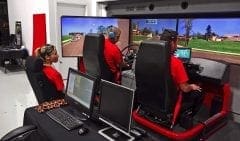Continuum of Training for Firefighters
Multiple Simulators, Many Participants, One Scenario
 The Continuum of Training is a multi-disciplinary, multiple participant capability for First Responder training. It maximizes participant learning with incremental “simple-to-complex” content-focused student learning. Each of the following training platforms is connected by a single scenario that plays out as in the field.
The Continuum of Training is a multi-disciplinary, multiple participant capability for First Responder training. It maximizes participant learning with incremental “simple-to-complex” content-focused student learning. Each of the following training platforms is connected by a single scenario that plays out as in the field.
It effectively simulates both the physical and emotional realities of a complex scenario: multi-jurisdictional incidents or multi-threat situations in a range of weather conditions and settings—airports, railways, industrial areas, city streets, etc. Every scenario is fully programmable and customizable and can be modified as it runs, keeping students on their toes. This offers all the benefits of hands-on practical training in a safe, cost-effective, and easy-to-coordinate setting.
COMMAND
Incommand prepares the commander for decision-making in scene management. This phase will also train other roles for preparation training for a full-scale incident. The simulation allows emergency crews to experience the event as they would in real life. They assess the situation and determine the best response strategy, implement it, and then observe the consequences of their decisions.
DRIVE
Be part of the solution by arriving at the scene safely. Driver training simulators, like the 2View Crew Trainer help identify the individual skills which will be required for the successful, safe operation of vehicles by First Responders. Training in this phase isolates individual skills within single events, coupled with proper judgment and decision-making repetition and recurrence to establish a “conditioned reaction” of fundamental skills.
SUPPRESS
Flaim Trainer prepares the student for fighting fires on the front line, in a safe, controlled environment by an immersive virtual reality simulation, combined with a haptic feedback system, breathing apparatus, and heated personal protective clothing. The student’s ability to apply technique and accuracy are tested during this phase.
![]()
OPERATE
Pump Ops trains firefighters on the safe operation of a pump engine. A “Sequential system” or “Sequential approach” to multi-faceted tasks are required for safe operation. Training in this phase involves an understanding of the “real” situation, such as hose configuration, managing water sources, water flow, friction coefficients, and radio communication.
RESCUE
Rescue is a primary objective at critical scenes. Response engages the student and develops their competencies through practice while preparing the student to have a controlled response to a crisis or medical situation. The simulator uses interactive video to take a student through the scenario, and their actions trigger outcomes that would result.


